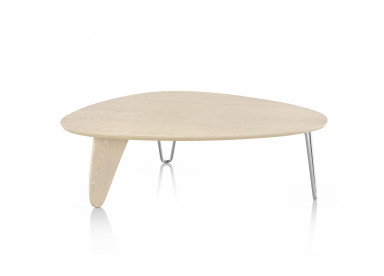


“Everything is sculpture,” said Isamu Noguchi. “Any material, any idea without hindrance born into space, I consider sculpture.”
Noguchi believed the sculptor’s task was to shape space, to give it order and meaning, and that art should “disappear”, or be as one with its surroundings. Perhaps it was his dual heritage – his father was a Japanese poet, his mother a Scottish-American writer – that resulted in his way of looking at the world with an eye for “oneness”.
Unwilling and unable to be pigeonholed, Noguchi created sculptures that could be as abstract as Henri Moore’s or as realistic as Leonardo’s. He used any medium he could get his hands on: stone, metal, wood, clay, bone, paper or a mixture of any or all – carving, casting, cutting, pounding, chiselling or dynamiting away as each form took shape.
“To limit yourself to a particular style may make you an expert of that particular viewpoint or school, but I do not wish to belong to any school,” he said. “I am always learning, always discovering.”
His extraordinary range of projects included playgrounds and plazas, furniture and gardens, the stone-carved busts, and Akari paper lights, so delicate they could be folded and put into an envelope. He also designed numerous stage sets for dancer-choreographer Martha Graham, who was as much an influence on him as was his mentor, Constantin Brancusi.
"Everything is sculpture."
Noguchi was intelligent, articulate and sensitive. During World War II, at a dark time in US history, he voluntarily entered a relocation camp for Japanese-Americans in Arizona – and then was unable to get permission to leave. After seven months, he was granted liberation. “I was finally free,” he said gratefully. “I resolved henceforth to be an artist only.
His relationship with Herman Miller came about when a design of his was used to illustrate an article written by George Nelson called “How to Make a Table”. It became his famous “coffee table”, originally introduced in 1947 and reissued in 1984.
Other notable commissions include the gardens for the UNESCO Building in Paris, five fountains for the Supreme Court Building in Tokyo and a high-relief mural for the Abelardo Rodriguez Market in Mexico City.
Noguchi died in 1988 after a brilliant career that spanned more than six decades. For someone who was told by his first art teacher at age 15 that he’d “never be a sculptor”, he left an amazing legacy.
Gold Medal, American Institute of Arts and Letters, 1977
Brandeis Creative Arts Award, 1966
New York Architectural League Gold Medal, 1965
First Prize (Logan Medal), 63rd Exhibition of Painting and Sculpture, Art Institute of Chicago, 1959
Guggenheim Memorial Fund Fellowship, 1927